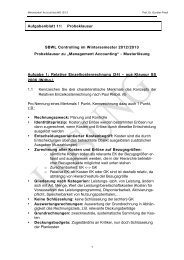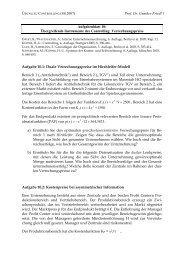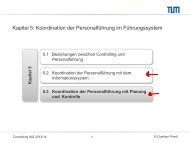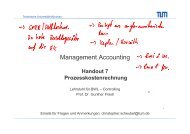Lecture 9 - Lehrstuhl für Controlling - Technische Universität München
Lecture 9 - Lehrstuhl für Controlling - Technische Universität München
Lecture 9 - Lehrstuhl für Controlling - Technische Universität München
Create successful ePaper yourself
Turn your PDF publications into a flip-book with our unique Google optimized e-Paper software.
<strong>Technische</strong> <strong>Universität</strong> <strong>München</strong><br />
Value-Based Management<br />
<strong>Lecture</strong> 9:<br />
Implementing Value-Based Management:<br />
Identifying the Drivers of Value Creation<br />
Prof. Dr. Gunther Friedl<br />
<strong>Lehrstuhl</strong> <strong>für</strong> <strong>Controlling</strong><br />
<strong>Technische</strong> <strong>Universität</strong> <strong>München</strong><br />
Email: gunther.friedl@wi.tu-muenchen.de
<strong>Technische</strong> <strong>Universität</strong> <strong>München</strong><br />
Overview<br />
1. Value Maximization and Corporate Objectives<br />
2. Measuring Income: Financial Statements<br />
3. Measuring Value Creation: Value-Based Performance Measures<br />
4. Management Compensation: Objectives and Alternatives<br />
5. Calculating the Cost of Capital<br />
6. Accounting Adjustments: Overview<br />
7. Accounting Adjustments: Goal Congruent Performance Measures<br />
8. Valuing and Managing Real Options<br />
9. Identifying the Drivers of Value Creation<br />
Value-Based Management: <strong>Lecture</strong> 9 2<br />
© Gunther Friedl – SS 2013
<strong>Technische</strong> <strong>Universität</strong> <strong>München</strong><br />
Required readings<br />
<br />
Young, S. David and O‘Byrne, Stephen F.: EVA and Value-Based Management: A<br />
Practical Guide to Implementation, New York et al. 2001, chapter 3 and 7.<br />
Suggested readings<br />
<br />
Kaplan, Robert S. and Norton, David P. (1996): Linking the Balanced Scorecard to<br />
Strategy, California Management Review 39, No. 1, pp 53-79.<br />
Value-Based Management: <strong>Lecture</strong> 9<br />
3<br />
© Gunther Friedl – SS 2013
<strong>Technische</strong> <strong>Universität</strong> <strong>München</strong><br />
Outline<br />
Implementing<br />
VBM: Identifying<br />
the Drivers of<br />
Value Creation<br />
9.1 Synergies and controllability<br />
9.2 Financial and non-financial value drivers<br />
9.3 Process-based performance measurement<br />
9.4 The implementation process<br />
Value-Based Management: <strong>Lecture</strong> 9<br />
4<br />
© Gunther Friedl – SS 2013
<strong>Technische</strong> <strong>Universität</strong> <strong>München</strong><br />
Calculating EVA for divisions assumes the independence of the<br />
divisions and neglects synergies<br />
<br />
<br />
<br />
Calculating EVA at the business unit level or even deeper in the organization<br />
requires that one can construct an income statement and a balance sheet for the<br />
considered unit.<br />
To create value companies try to achieve synergies through interaction of their<br />
divisions in two possible ways:<br />
• Several divisions share facilities like R&D, IT,<br />
Human resource management, product design,<br />
marketing.<br />
Problem of the allocation of costs (and<br />
shares of the invested capital) to the divisions.<br />
• Vertical integration to help the company<br />
better control its value chain.<br />
Product Line A<br />
Purchasing<br />
Company<br />
R & D<br />
Production<br />
Product Line B<br />
Requirement of transfer prices for assets and services to establish business<br />
unit revenues (always arbitrary to a certain degree).<br />
EVA implementation therefore is of little use when large percentages of the business<br />
unit assets are shared facilities or a large part of the costs of goods sold is<br />
represented by intercompany transactions.<br />
Sales<br />
Value-Based Management: <strong>Lecture</strong> 9<br />
5<br />
© Gunther Friedl – SS 2013
<strong>Technische</strong> <strong>Universität</strong> <strong>München</strong><br />
EVA of the sales divisions of the Metro Group – based on own balance<br />
sheets and income statements<br />
Development of EVA (Source: Metro Group Annual Report 2008, p.81)<br />
Value-Based Management: <strong>Lecture</strong> 9 6<br />
© Gunther Friedl – SS 2013
<strong>Technische</strong> <strong>Universität</strong> <strong>München</strong><br />
ThyssenKrupp AG - Annual Report 2009 / 2010<br />
Components of ThyssenKrupp Value Added (TKVA)<br />
Value-Based Management: <strong>Lecture</strong> 9 7<br />
© Gunther Friedl – SS 2013
<strong>Technische</strong> <strong>Universität</strong> <strong>München</strong><br />
Some practices representing potential “solutions” to the synergy<br />
problem<br />
Solution approach<br />
• Creation of groups of divisions<br />
• Linking part of the EVA bonus<br />
to EVA in another division<br />
• Cost allocation on the basis of<br />
divisional profitability<br />
• Activity-based costing<br />
• Other approaches to transfer<br />
pricing like an internal auction<br />
Idea and drawbacks of the approach<br />
• Solves partly the allocation or transfer pricing<br />
problem between the grouped divisions but not<br />
between different groups<br />
• Measurement problem remains for divisional<br />
manager’s performance<br />
• New bureaucratic hurdle for divisional managers<br />
and free-rider problem<br />
• Encourages cooperation and reduces the conflicts<br />
due to overhead allocation or transfer pricing<br />
• Addresses cost allocation and transfer pricing<br />
problem by rewarding cooperation<br />
• Might give incentives not to care enough for the own<br />
division’s profitability<br />
• Identifies cost drivers to better allocate overhead<br />
costs<br />
• Tries to more accurately capture the prices that the<br />
units would observe if they were truly independent<br />
Value-Based Management: <strong>Lecture</strong> 9<br />
8<br />
© Gunther Friedl – SS 2013
<strong>Technische</strong> <strong>Universität</strong> <strong>München</strong><br />
Outline<br />
Implementing<br />
VBM: Identifying<br />
the Drivers of<br />
Value Creation<br />
9.1 Synergies and controllability<br />
9.2 Financial and non-financial value drivers<br />
9.3 Process-based performance measurement<br />
9.4 The implementation process<br />
Value-Based Management: <strong>Lecture</strong> 9<br />
9<br />
© Gunther Friedl – SS 2013
<strong>Technische</strong> <strong>Universität</strong> <strong>München</strong><br />
Managers cannot be judged for decisions they are not responsible for:<br />
the controllability problem<br />
<br />
<br />
Companies engage in operating, investing, and financing activities<br />
The manager of a responsibility center has significant decision-making authority<br />
over some aspects of these activities:<br />
Cost center Profit center Investment center<br />
Decision-making<br />
authority<br />
Controls only<br />
inputs/expenses<br />
Controls input and<br />
output<br />
Controls operating<br />
profit and capital used<br />
Performance<br />
evaluation<br />
Input-output<br />
productivity measures<br />
Operating profit, gross<br />
margin<br />
RONA, EVA<br />
<br />
EVA is a “total factor” measure of performance as it incorporates the income<br />
statement as well as the balance sheet<br />
EVA is fully appropriate only as a performance measure for investment centers<br />
When EVA is inappropriate management must use value drivers that are<br />
strongly correlated with EVA, easier to measure and more controllable by the<br />
unit manager to evaluate the business unit’s value creating performance<br />
Value-Based Management: <strong>Lecture</strong> 9<br />
10<br />
© Gunther Friedl – SS 2013
<strong>Technische</strong> <strong>Universität</strong> <strong>München</strong><br />
Financial and non-financial value drivers – identifying the Key<br />
Performance Indicators (KPIs) (1/3)<br />
<br />
Financial drivers: Components of EVA like RONA or components of RONA itself<br />
like working capital ratios (for example the DuPont Analysis)<br />
EVA<br />
( RONA – WACC ) ∙ invested capital<br />
„Profit margin“<br />
(profitability)<br />
x<br />
Asset turnover<br />
(activity)<br />
Financing decisions<br />
(optimal capital structure)<br />
Investment decisions<br />
(capital allocation)<br />
NOPAT<br />
: Sales<br />
Sales :<br />
Invested capital<br />
Contribution<br />
(margin)<br />
Sales –<br />
–<br />
Fixed costs<br />
• production overhead<br />
• administrative overhead<br />
• distribution and<br />
marketing overhead<br />
Variable costs<br />
Fixed assets<br />
• fixed asset turnover<br />
Working capital<br />
• inventory period<br />
• receivables period<br />
• payables period<br />
Value-Based Management: <strong>Lecture</strong> 9<br />
11<br />
© Gunther Friedl – SS 2013
<strong>Technische</strong> <strong>Universität</strong> <strong>München</strong><br />
Financial and non-financial value drivers – identifying the Key<br />
Performance Indicators (KPIs) (2/3)<br />
<br />
Some shortcomings of financial drivers:<br />
• Short-term performance might be achieved at the cost of the long run<br />
(maximizing the present value of future EVAs must be the objective)<br />
• “milking assets”, reduced production quality at the cost of customer satisfaction<br />
and future revenues etc.<br />
• Financial ratios are of historical nature (lagged indicators)<br />
<br />
Non-financial drivers might help to cope with these problems:<br />
• Leading indicators of future EVA like market share, customer satisfaction,<br />
product innovation, the number of new customers or employee skills and<br />
employee satisfaction…<br />
• …might be more under control of operating managers and<br />
• …capture problems quicker (customer complaints as signal of problems of<br />
product quality or distributional problems).<br />
Value-Based Management: <strong>Lecture</strong> 9 12<br />
© Gunther Friedl – SS 2013
<strong>Technische</strong> <strong>Universität</strong> <strong>München</strong><br />
Financial and non-financial value drivers – identifying the Key<br />
Performance Indicators (KPIs) (3/3)<br />
<br />
<br />
<br />
While business unit managers rely on more global performance measures,<br />
department managers need more specific work flow measures which they can<br />
control on a day-to-day basis.<br />
Production employees, for example, should be given rather weekly incentive<br />
bonuses (based on productivity targets, for instance) for an immediate feedback<br />
than yearly bonuses based on profit measures<br />
Examples of value drivers / KPIs for different departments of a company which<br />
usually are not organized as investment centers:<br />
• Materials department: order fill rate, time from receipt of material to delivery to<br />
production, damaged scrap, obsolete excess etc.<br />
• Production department: production cycle time, inventory, in-process scrap etc.<br />
• Distribution department: percentage of problem-free installs and deliveries (time<br />
and quantity), number of returns etc.<br />
• Marketing department: sales per product / employee, customer satisfaction and<br />
customer loyalty, market share per region etc.<br />
Value-Based Management: <strong>Lecture</strong> 9 13<br />
© Gunther Friedl – SS 2013
<strong>Technische</strong> <strong>Universität</strong> <strong>München</strong><br />
A balanced scorecard combines financial as well as non-financial<br />
value drivers<br />
<br />
Apart from the financial perspective (with the EVA as the top level performance<br />
measure, for instance) other, non-financial perspectives are explicitly taken into<br />
account as a means of supporting shareholder value creation<br />
Financial Perspective<br />
To succeed financially,<br />
how should we appear to our shareholders?<br />
objectives measures targets initiatives<br />
Customer Perspective<br />
To achieve our vision,<br />
how should we appear to our customers?<br />
objectives measures targets initiatives<br />
Vision and<br />
Strategy<br />
Internal Business Process<br />
To satisfy our shareholders and customers,<br />
what business processes must we excell at?<br />
objectives measures targets initiatives<br />
Learning and Growth<br />
To achieve our vision, how will<br />
we sustain our ability to cange and improve?<br />
objectives measures targets initiatives<br />
Value-Based Management: <strong>Lecture</strong> 9<br />
14<br />
Figure adapted from Kaplan / Norton (1996)<br />
© Gunther Friedl – SS 2013
<strong>Technische</strong> <strong>Universität</strong> <strong>München</strong><br />
Examples of possible performance measures in the four „classic“<br />
dimensions of the balanced scorecard<br />
<br />
Financial Perspective<br />
<br />
Customer perspective<br />
• Economic value added<br />
• Customer profitability<br />
• Market value added<br />
• Repeat customers<br />
• Return on investment / return on<br />
net assets<br />
• Growth in sales<br />
• Customer surveys<br />
• Number of customer complaints<br />
• On-time delivery<br />
• Service response times<br />
<br />
Internal business process<br />
<br />
Learning and growth<br />
• Dealer quality<br />
• Employee motivation<br />
• Process cost<br />
• Employee empowerment<br />
• Nb. of units requiring reworking<br />
• Information systems capabilities<br />
• Length of operating cycle<br />
• Employee capabilities<br />
• Volumes of goods shipped<br />
• Number of employee suggestions<br />
• Optimal asset utilization<br />
• Hours spent on training employees<br />
Value-Based Management: <strong>Lecture</strong> 9 15<br />
© Gunther Friedl – SS 2013
Leading Lagging<br />
The Leading-Lagging Continuum<br />
<strong>Technische</strong> <strong>Universität</strong> <strong>München</strong><br />
The „strategy map“ presents the Key Performance Indicators in a<br />
causal chain<br />
Financial<br />
Accounts<br />
receivable<br />
Economic value added<br />
Operating<br />
expenses<br />
Customers<br />
Customers<br />
satisfaction<br />
On-time delivery<br />
Internal<br />
Business<br />
Processes<br />
Shorter<br />
cycle time<br />
Process quality<br />
Lower<br />
rework<br />
Learning<br />
and Growth<br />
Employee<br />
skills<br />
Employee morale<br />
Employee<br />
suggestions<br />
Value-Based Management: <strong>Lecture</strong> 9<br />
16<br />
© Gunther Friedl – SS 2013
<strong>Technische</strong> <strong>Universität</strong> <strong>München</strong><br />
Use of non-financial performance measures even in top management<br />
compensation<br />
Study of Ittner / Larcker / Rajan (1997): 36 % of the firms in their sample (114 of 317<br />
US companies) employ non-financial measures in evaluating CEO performance<br />
<br />
<br />
Non-financial performance measures of those 114 firms:<br />
Choice of performance measure<br />
depends on the corporate strategy<br />
of the firm:<br />
• Cost leadership (importance of<br />
operating efficiency)<br />
Operating profit, RONA<br />
and EVA are relatively<br />
informative measures<br />
• Differentiation (importance of<br />
long-term value creation for<br />
innovators and prospectors)<br />
Leading indicators of longterm<br />
value creation necessary<br />
Performance measure<br />
Percentage<br />
Customer satisfaction 36.8 %<br />
Employee satisfaction 8.7 %<br />
Product or service quality 21.0 %<br />
Efficiency or productivity 14.9 %<br />
Employee safety 16.6 %<br />
Market share 11.4 %<br />
Non-financial strategic objectives 28.0 %<br />
Process improvements and re-engineering 8.7 %<br />
New product development 6.1 %<br />
Innovation 2.6 %<br />
Employee development and training 7.0 %<br />
Other non-financial measures 65.5 %<br />
Value-Based Management: <strong>Lecture</strong> 9<br />
17<br />
© Gunther Friedl – SS 2013
<strong>Technische</strong> <strong>Universität</strong> <strong>München</strong><br />
Outline<br />
Implementing<br />
VBM: Identifying<br />
the Drivers of<br />
Value Creation<br />
9.1 Synergies and controllability<br />
9.2 Financial and non-financial value drivers<br />
9.3 Process-based performance measurement<br />
9.4 The implementation process<br />
Value-Based Management: <strong>Lecture</strong> 9<br />
18<br />
© Gunther Friedl – SS 2013
<strong>Technische</strong> <strong>Universität</strong> <strong>München</strong><br />
Processes involving several operating units require performance measures<br />
focusing on processes instead of organizational boundaries<br />
<br />
The performance measurement system for so called “core processes” must<br />
consider the critical elements of the process by setting concrete operating objectives<br />
• “Core Processes” are processes that cut horizontally through a company and<br />
have no organizational boundaries like profit centers:<br />
• “Core Processes” are, for example, new product development, customer service,<br />
supplier management or order fulfillment<br />
<br />
Developing a performance measurement system for a core process<br />
• Map the process, identify the sequence of activities and the key players<br />
• Determine the areas where performance indicators are critical to the success of<br />
the process<br />
Value-Based Management: <strong>Lecture</strong> 9 19<br />
© Gunther Friedl – SS 2013
<strong>Technische</strong> <strong>Universität</strong> <strong>München</strong><br />
Example: Performance pyramid for a computer manufacturer<br />
Vision:<br />
„To provide fault-tolerant computer<br />
solutions to financial service companies“<br />
Corporate<br />
Vision<br />
Objectives defined on<br />
business unit level<br />
Market (i.e.<br />
Share<br />
Growth)<br />
Financial<br />
(i.e. EVA)<br />
Core processes<br />
Critical elements of a core<br />
process (customer<br />
satisfaction, flexibility,<br />
productivity) and their<br />
global measures<br />
Customer<br />
satisfaction<br />
No. of<br />
complaints<br />
Survey results<br />
Repeat sales<br />
Flexibility<br />
Responsivene<br />
ss to order or<br />
configuration<br />
changes<br />
Productivity<br />
Inventory<br />
turns Cycle<br />
Times<br />
Goals on<br />
department<br />
level<br />
Quality Delivery Cycle Time Waste<br />
Value-Based Management: <strong>Lecture</strong> 9<br />
20<br />
© Gunther Friedl – SS 2013
Department measures<br />
<strong>Technische</strong> <strong>Universität</strong> <strong>München</strong><br />
The core process „order fulfillment“: Specific workflow/operating<br />
measures for each department with a key role in the process<br />
Core process<br />
„order fulfillment“<br />
Customer<br />
satisfaction<br />
Flexibility<br />
Productivity<br />
Quality Delivery Cycle Time Waste<br />
Materials<br />
department<br />
Good parts<br />
Cycle count<br />
accuracy<br />
Order fill rate (no<br />
line outs)<br />
Time from receipt<br />
of material to<br />
delivery to<br />
production<br />
Incoming inspection<br />
Scrap, damaged<br />
Rehandling<br />
Load on the plant<br />
Excess, obsolete<br />
Production<br />
department<br />
% functional<br />
% with<br />
complete<br />
information<br />
% on time:<br />
to schedule<br />
to special request<br />
Production cycle<br />
time<br />
Rework<br />
Inspection<br />
Inventory<br />
In-process scrap<br />
Distribution<br />
department<br />
% problem-free<br />
installs:<br />
„plug and play“<br />
% problem-free<br />
deliveries (time,<br />
quantity, place):<br />
to schedule<br />
to special request<br />
Material throughout<br />
time<br />
Order throughout<br />
time<br />
% rework time<br />
Number of returns<br />
Penalties for late<br />
delivery<br />
Value-Based Management: <strong>Lecture</strong> 9<br />
21<br />
© Gunther Friedl – SS 2013
<strong>Technische</strong> <strong>Universität</strong> <strong>München</strong><br />
Outline<br />
Implementing<br />
VBM: Identifying<br />
the Drivers of<br />
Value Creation<br />
9.1 Synergies and controllability<br />
9.2 Financial and non-financial value drivers<br />
9.3 Process-based performance measurement<br />
9.4 The implementation process<br />
Value-Based Management: <strong>Lecture</strong> 9<br />
22<br />
© Gunther Friedl – SS 2013
<strong>Technische</strong> <strong>Universität</strong> <strong>München</strong><br />
EVA is an instrument for changing managerial behavior and corporate<br />
culture<br />
<br />
Implementation of VBM requires acceptance and understanding of sound financial<br />
theory and value-based principles like NPV by all managers<br />
<br />
Value creation is everyone’s responsibility in the company<br />
Finance departments should<br />
• provide transparency in the finance and accounting functions in order to help the<br />
operating departments understand and achieve their financial goals and<br />
• communicate clear goals to the employees and achieve their “buy-in” because<br />
the real value creators are the operating divisions<br />
Value-Based Management: <strong>Lecture</strong> 9 23<br />
© Gunther Friedl – SS 2013
<strong>Technische</strong> <strong>Universität</strong> <strong>München</strong><br />
The EVA implementation process is intensely company-specific and<br />
might follow 4 steps<br />
Step 1:<br />
<br />
Establish total acceptance at the board and top management levels as basis<br />
for further implementation<br />
Step 2:<br />
Major<br />
strategic<br />
decisions<br />
on the<br />
EVA<br />
program<br />
<br />
<br />
<br />
Define the EVA measurement centers, for example on the basis of existing<br />
profit centers with the advantage that<br />
• profit centers have the necessary responsibilities<br />
• the required financial reporting systems exist<br />
Fix the frequency and the way of how to calculate EVA:<br />
• Possible adjustments to the company’s accounting system for a “better“<br />
EVA (attention to also growing complexity!)<br />
• Consideration of IT constraints<br />
• Divisional versus corporate cost of capital<br />
Design the management compensation system (decision to be made by top<br />
management):<br />
• Who will be covered initially and at a later date?<br />
• Sensitivity of bonuses to EVA performance<br />
• Will there be a deferred component?<br />
• Role of stock options in the compensation program<br />
• Divisional versus company-wide or group EVA bonuses<br />
• Relation to nonfinancial measures<br />
Value-Based Management: <strong>Lecture</strong> 9<br />
24<br />
© Gunther Friedl – SS 2013
<strong>Technische</strong> <strong>Universität</strong> <strong>München</strong><br />
The EVA implementation process is intensely company-specific and<br />
might follow 4 steps<br />
Step 3:<br />
<br />
Development of an implementation plan<br />
<br />
working out the technical details<br />
Step 4:<br />
Set up a<br />
training<br />
program<br />
<br />
<br />
<br />
Necessary to get the commitment to value creation from the company’s<br />
employees<br />
Select the persons that need the training<br />
Number and concept of training sessions, for example:<br />
• First session to introduce the employees to the concept of EVA<br />
• Second session to give more details about the calculation and<br />
interpretation of the EVA numbers and some ideas of how to increase the<br />
EVA of the divisions<br />
• Subsequent sessions to introduce the compensation plan<br />
Value-Based Management: <strong>Lecture</strong> 9<br />
25<br />
© Gunther Friedl – SS 2013
















